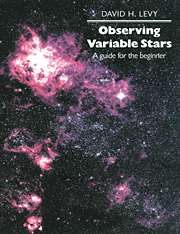Book contents
- Front Matter
- Contents
- Foreword
- Opening thoughts
- Acknowledgments
- Part 1 Getting to know the sky
- 1 Beginning with the Big Dipper
- 2 Magnitude, color, and distance
- 3 A word on binoculars and telescopes
- 4 Learning to see
- Part 2 Getting to know the variables
- Part 3 Suggested variables for observation throughout the year
- Part 4 A miscellany
- Index
3 - A word on binoculars and telescopes
Published online by Cambridge University Press: 22 September 2009
- Front Matter
- Contents
- Foreword
- Opening thoughts
- Acknowledgments
- Part 1 Getting to know the sky
- 1 Beginning with the Big Dipper
- 2 Magnitude, color, and distance
- 3 A word on binoculars and telescopes
- 4 Learning to see
- Part 2 Getting to know the variables
- Part 3 Suggested variables for observation throughout the year
- Part 4 A miscellany
- Index
Summary
Someone may have once told you that astronomy calls for large, expensive equipment. You may even have flipped through the pages of an astronomy magazine in amazement at all the fantastic technology on display there. At some point in your development as an astronomer, you may feel that a telescope will build your interest and extend the power of your observations. For now, you are probably much better off with a simple pair of binoculars, and this is true for viewing some variable stars. Because binoculars are mass-produced and sold almost everywhere, they are far less expensive than are telescopes, even those of the same size. By taking advantage of both your eyes, binoculars present the sky in an efficient, almost three-dimensional way. In variable star observations binoculars are used widely, for many of the semiregular variables are bright enough to be followed with them.
The only problem with binoculars is that the two small telescopes that form their optical system must be precisely aligned. So many binoculars lose their adjustment with the bumps and insults of regular use. You should at least be sure to start with a good pair; test them before purchasing by pointing them to a distant building or mountain. Holding them securely, make certain that the image in one side is precisely the same as that in the other; landmarks should fall in the same place in both circular fields of view.
- Type
- Chapter
- Information
- Observing Variable StarsA Guide for the Beginner, pp. 9 - 14Publisher: Cambridge University PressPrint publication year: 1989

